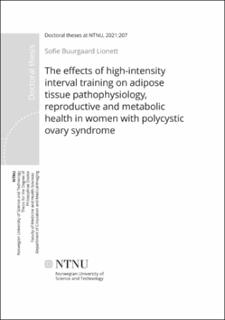| dc.contributor.advisor | Moholdt, Trine | |
| dc.contributor.advisor | Hawley, John | |
| dc.contributor.author | Lionett, Sofie Buurgaard | |
| dc.date.accessioned | 2021-06-09T13:54:58Z | |
| dc.date.available | 2021-06-09T13:54:58Z | |
| dc.date.issued | 2021 | |
| dc.identifier.isbn | 978-82-326-5600-4 | |
| dc.identifier.issn | 2703-8084 | |
| dc.identifier.uri | https://hdl.handle.net/11250/2758729 | |
| dc.description.abstract | Polycystic ovary syndrome (PCOS) is the most common endocrine disorder in reproductive-aged women, affecting up to 13% of women worldwide and has wideranging reproductive, metabolic and psychological health implications. Still, the etiology and optimal therapies for PCOS remain unclear. Even if lifestyle modification, including exercise training, is the first-line therapy for improving reproductive, metabolic and psychological features in PCOS, there is currently no specific exercise prescription for the management of PCOS. Therefore, the primary aim of the IMproving Reproductive function in women with Polycystic OVary syndrome with high-intensity Interval Training (IMPROV-IT) trial (Paper I and II) was to investigate whether 16 weeks of either low-volume or high-volume semi-supervised high-intensity interval training (HIT), followed by subsequent 36 weeks of home-based HIT could increase menstrual frequency in women with PCOS during a 1-year period. Secondary aims were to examine the effects of HIT on cardiorespiratory fitness, rates of pregnancies, whole-body insulin sensitivity, and quality of life.
IMPROV-IT was a two-center randomized controlled trial (RCT) that included 64 women with PCOS. The participants were randomly allocated (1:1:1) to either: lowvolume HIT (LV-HIT, 3 days/week of 10 x 1 min work bouts at maximal, sustainable intensity); high-volume HIT (HV-HIT, 3 days/week of 4 x 4 min work bouts at 90-95% of maximal heart rate); or non-exercise control (Non-Ex). Outcome measures were assessed at baseline, after 16 weeks and 12 months after baseline. The main findings in IMPROV-IT were that there were no between-group differences in menstrual frequency at 12 months but a significant increase in menstrual frequency from baseline to 12 months in all three groups including in the Non-Ex (control) group. Furthermore, pregnancy rates increased significantly after LV-HIT. Adherence to the exercise protocols was poor which may explain the lack of difference between groups in menstrual frequency as well as limited findings in secondary outcome measures (including insulin sensitivity and cardiorespiratory fitness). Quality of life improved in two out of five PCOS-related domains (infertility problems and body hair) in the HV-HIT group compared to the control group at 12 months follow-up.
The complex relationship between multiple biological systems may partly explain the limited understanding of the etiology of PCOS. Adipose tissue dysfunction has been suggested to play a central role in the metabolic abnormalities observed in PCOS. The aims of Paper III and IV were to compare the expression of selected microRNAs in adipose tissue (and the circulation), fat cell size, rates of whole-body fat oxidation during submaximal exercise and rates of mitochondrial respiration in adipose tissue taken from women with and without PCOS. We also investigated the response to 16 weeks of HIT in these outcome measures in both groups of women. The main findings of Paper III were that the expression of circulating microRNA-27b was increased in PCOS, and that the expression of this microRNA was reduced after 16 weeks of LV-HIT. No differences were observed in the eight selected microRNAs in adipose tissue taken from women with and without PCOS, or following 16 weeks of LV- or HV-HIT. The main finding of Paper IV was that rates of whole-body fat oxidation during submaximal exercise only improved in women without, but not with PCOS, despite similar increases in cardiorespiratory fitness, indicating metabolic inflexibility in women with PCOS. Furthermore, we found that at baseline, women with PCOS had lower mitochondrial respiration through complex I + II in subcutaneous abdominal adipose tissue compared to women without PCOS, which supports the notion that abnormal adipose tissue may play a central role in PCOS pathophysiology. | en_US |
| dc.language.iso | eng | en_US |
| dc.publisher | NTNU | en_US |
| dc.relation.ispartofseries | Doctoral theses at NTNU;2021:207 | |
| dc.relation.haspart | Paper 1: Kiel, Ida Almenning; Lionett, Sofie Buurgaard; Parr, Evelyn B.; Jones, Helen; Røset, Maria Aurora Hernandez; Salvesen, Øyvind; Vanky, Eszter; Moholdt, Trine. Improving reproductive function in women with polycystic ovary syndrome with high-intensity interval training (IMPROV-IT): study protocol for a two-centre, three-armed randomised controlled trial.. BMJ Open 2020 ;Volum 10:e0344733.(2) s. 1-9 http://dx.doi.org/10.1136/bmjopen-2019-034733 This is an open access article distributed in accordance with the Creative Commons Attribution Non Commercial (CC BY-NC 4.0) license | en_US |
| dc.relation.haspart | Paper 2:
Kiel, Ida Almenning; Lionett, Sofie Buurgaard; Parr, Evelyn B.; Jones, Helen; Røset, Maria Aurora Hernandez; Salvesen, Øyvind; Hawley, John Alan;
Vanky, Eszter; Moholdt, Trine.
Improving Reproductive Function in Women with Polycystic Ovary Syndrome with High-Intensity Interval Training (IMPROV-IT): a twocentre, three-armed randomized controlled trial | en_US |
| dc.relation.haspart | Paper 3: Lionett, Sofie Buurgaard; Kiel, Ida Almenning; Camera, Donny M; Vanky, Eszter; Parr, Evelyn B.; Lydersen, Stian; Hawley, John A; Moholdt, Trine. Circulating and Adipose Tissue miRNAs in Women With Polycystic Ovary Syndrome and Responses to High-Intensity Interval Training. Frontiers in Physiology 2020 ;Volum 11. https://doi.org/10.3389/fphys.2020.00904 This is an open-access article distributed under the terms of the Creative Commons Attribution License (CC BY) | en_US |
| dc.relation.haspart | Paper 4: Lionett, Sofie Buurgaard; Kiel, Ida Almenning; Røsbjørgen, Ragnhild; Lydersen, Stian; Larsen, Steen; Moholdt, Trine. Absent exercise-induced improvements in fat oxidation in women with polycystic ovary syndrome after high-intensity interval training. Frontiers in Physiology 2021 ;Volum 12:649794. s. 1-13 https://doi.org/10.3389/fphys.2021.649794 This is an open-access article distributed under the terms of the Creative Commons Attribution License (CC BY) | en_US |
| dc.title | The effects of high-intensity interval training on adipose tissue pathophysiology, reproductive and metabolic health in women with polycystic ovary syndrome | en_US |
| dc.type | Doctoral thesis | en_US |
| dc.subject.nsi | VDP::Medical disciplines: 700::Health sciences: 800 | en_US |

